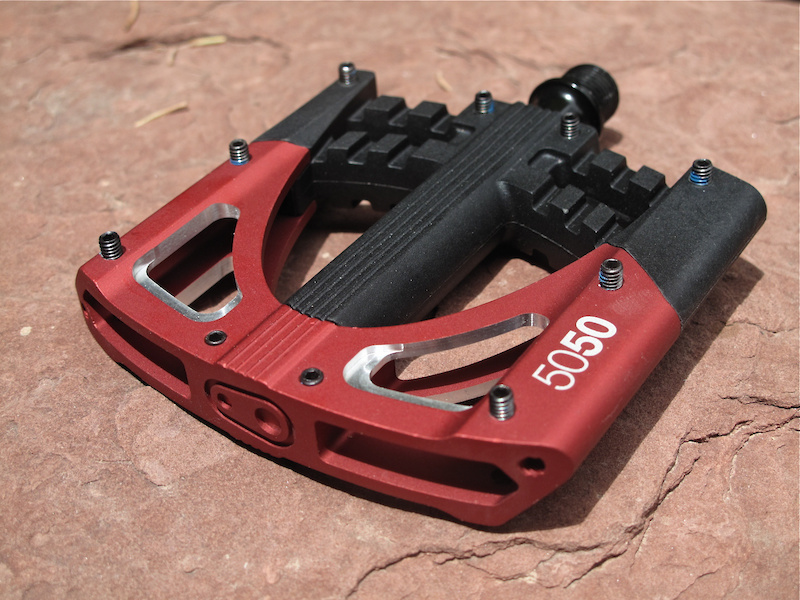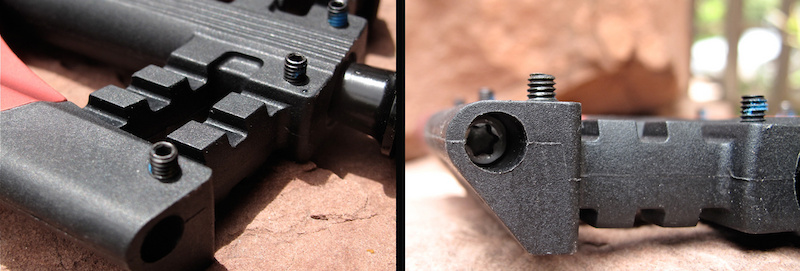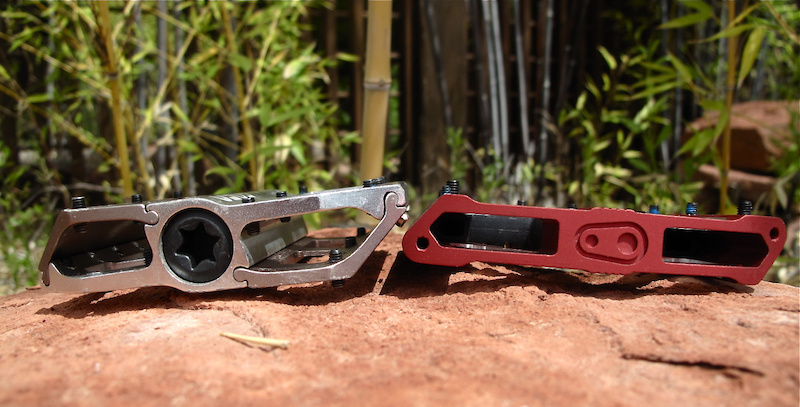Right from PB:
What is it: Crank Brothers' fresh 5050 platform pedal is completely new from the ground up, sharing next to nothing with the original version. Using a unique two piece design that employs different materials - aluminum for the platform's outer section and polycarbonate for the inner - these novel pedals are quite different from other options on the market. There are two versions available: a 428 gram, black and silver version that retails for $80 USD and spins on a combination of a bushings and cartridge bearings, and a black and red, 433 gram model that features a body with more cutouts to shed both weight and mud, as well as rotating on both needle and cartridge bearings. Both models come from Crank Brothers with a five year warranty.

Crank Brothers' redesigned 5050 pedals are completely new for 2012 and feature a novel two piece aluminum and polycarbonate body. The higher end 5050 3 model shown above uses a combination of needle and cartridge bearings.
Crank Brothers 5050 pedal details:
- Entirely new design for 2012
- Two piece aluminum and polycarbonate platform
- Forged scm435 chromoly steel spindles
- Height adjustable set screw traction pins (10 per side)
- 5050 3 uses needle/cartridge bearings, weighs 433g and retails for $100 USD
- 5050 2 uses bushing/cartridge bearings, weighs 428g and retails for $80 USD.
- Both models have 5 year warranty.
- Available in July
The details:
Crank Brothers' 5050 pedals are not an evolution of the original model, but rather a completely new design. The most obvious difference between the old and new models is the body, with the 2012 version being a hybrid that uses a polycarbonate inner section combined with a more traditional aluminum outer segment. The question is, why mix the two materials? Crank Brothers says that the polycarbonate is lighter than the aluminum that it replaces, while still being very resilient to abuse that it would see while attached to the crank arms of a downhill bike. Even if it is lighter, it would no doubt incur damage in short order if the entire pedal was made from polycarbonate, which is why the outer section, the part of the pedal that is likely to strike the ground, is still made from aluminum. Two torx bolts hold the two sections together, making them easy to replace if the worst does happen. Total pedal height for the new model is 5mm slimmer than the original version.
The new pedals are also drastically different internally, with both models using a forged scm435 chromoly spindle that Crank Brothers claims is 50% stronger thanks to a new shape that can better handle high loads. The new two piece body is also far better sealed against the elements than the original design which should greatly extend bearing life. Traction is provided by 10 set screw pins on each side, all being adjustable in height to allow you to fine tune the grip to your liking.

The pedal's polycarbonate inner section is mated to the aluminum outer portion with sturdy torx bolts (left) that are hidden from damage within the pedal body.

The new 5050 pedals (right) are 5mm slimmer than the original design (left).
First impressions:
Spending a few days on the new 5050 pedals clearly doesn't warrant a proper review - it's the long term impressions and reliability that count - but the new Crank Brothers platforms certainly do look promising. My Commencal demo bike was fitted with the less expensive, bushing and cartridge bearing equipped 5050 2 pedals, and unlike many other bushing based designs, they spun free and smooth despite being brand new. There are good arguments for both flat top pins (they tend to stand up better against rock strikes and are easier to replace) and the set screw pins that are fitted to the 5050's (the open top and sharper edges usually do provide more grip than most flat top studs), but I do prefer the latter. Traction was impressive, despite the height adjustable pins being set relatively low, and I never managed to slip a single pedal during my time on them. There is a slight amount of concave shaping to the pedal body that helps increase purchase, but this can be increased further by dialing out the pins along the body's leading and trailing edges while leaving the inner pins set low.
I did manage to ding them off a few rocks, thanks to some mis-timed pedaling, but they didn't look any worse for wear after my time on them. While the pedal body appears to be up to the task, I can't comment on their long term durability at this point. Looking at the new 5050 pedals, it is clear that Crank Brothers took the criticism of their original design and went back to the drawing board in an effort to build a more reliable platform pedal - stronger axles and better sealing should help answer the doubters. Stay tuned for more long term impressions down the road and look for out for Sam Hill, Aaron Gwin, Steve Peat and other riders using them on the World Cup circuit.